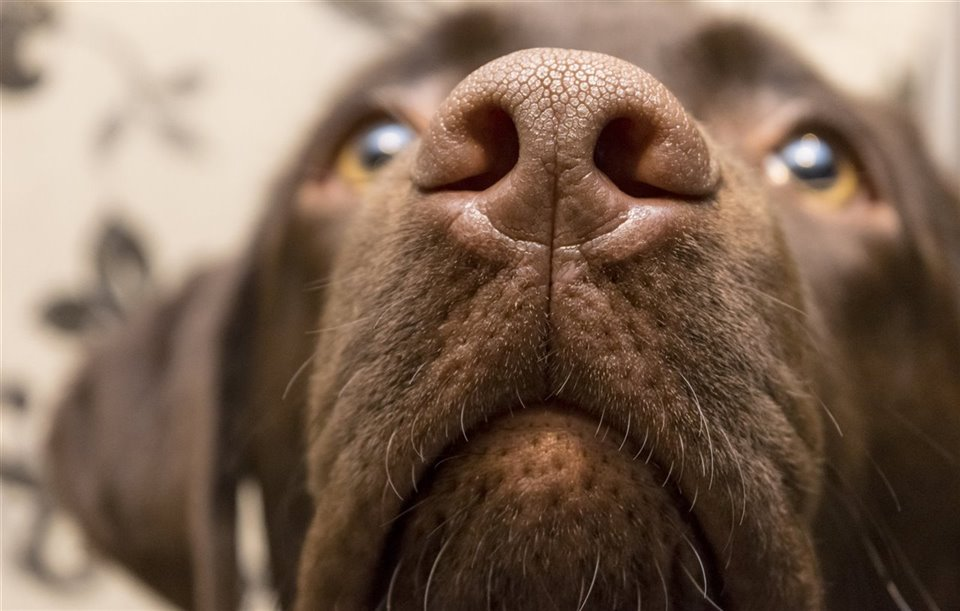
It is very likely that if you have a dog, you have been able to observe it in the field avidly chasing a scent trail. Sometimes, the perception that this produces is that the animal is basically guided by its sense of smell, as if concentrating entirely on it, leaving sight in the background. And this is exactly what happens.
Contrary to human beings, who acquire the most information from the environment that surrounds us through the sense of sight, dogs understand the world in a way that it is impossible for us to decipher, through their smell, one of the most developed from the animal kingdom. This is so to the point that, thanks to its sense of smell, a dog can even tell the time.
This is possible thanks to its wonderful snout, also known as the nose, which can vary considerably between different shapes and sizes (in fact, the pattern of a dog's nose is like the fingerprint of a person, unique and unrepeatable) allows dogs understand the world in a very different and surprising way at the same time. In addition, it has been shown that the larger and longer a dog's nose is, the better its sense of smell will be.
The pattern of a dog's nose is like a person's fingerprint, unique and unrepeatable
But to start talking about the sense of smell of dogs, we are forced to start with their brain, since, helped by the sense organs, it is ultimately the brain of living beings that processes information from the environment that surrounds us, being the first mere instruments for this purpose.
Thus, when it comes to dogs, the part of the brain responsible for processing the sense of smell is the largest. We will also say that the airways of a dog are directly connected to the amygdala, the brain area in which it is believed that memory is housed and in which it is known that emotions are processed. This allows dogs, in addition to being able to accurately detect the mood of the people around them, to also accurately remember each of the smells that they have recognized throughout their lives, compensating for other senses, such as that of the sight, in which in comparison with other animals they present more deficiencies.
The world through smell
But despite the importance of the brain, we cannot ignore the virtuous olfactory organ of dogs. The nose of dogs is special for several reasons, and very different from that of other mammals, such as primates. Unlike us humans, who breathe and smell through the same nasal passage, dogs have a passage inside their nostrils separating these two functions. That is, the nostrils of dogs are divided into two pathways, one intended to lead the air to the lungs, and the other to their olfactory system. In turn, each of the holes in a dog's nose works independently, allowing it to identify the origin and direction of each odor.
To understand how the sense of smell works in dogs, we will represent the path of air inside the snout of a dog. Thus, once it enters through the nose, the air intended to be sniffed first passes through a membrane, the olfactory mucosa, located on the roof of the animal's palate before ending up in the so-called vomeronasal or Jacobson's organ, a structure that It forms a kind of bag in which, so to speak, the different aromas found in the air are decanted. Subsequently, these aromas will be classified by a tissue made up of millions of olfactory cells, the olfactory epithelium.
It is precisely in these cells that the true secret of smell in dogs is found, since depending on the breed, dogs can have between 150 thousand and 300 billion of these cells, which allows them to recognize up to a million of different odors, a not insignificant amount considering that human beings barely have only five million of them.
These are some of the reasons why dogs' sense of smell is so acute. Human beings lack it, however, in a certain way we have learned to see the world through our best friends. Some examples are found in bloodhounds, which, being able to follow odorous trails left up to 48 hours after alteration, are tremendously effective when it comes to helping in rescue tasks or in the search for the disappeared.
It has also recently been shown that dogs can detect epileptic seizures in advance thanks to their powerful sense of smell, detect diseases such as COVID-19 or cancer, and even help us fight against the loss of biodiversity. Just a few examples that if we take care of our dogs, they will unconditionally take care of us. (Text and photo: National Geographic)